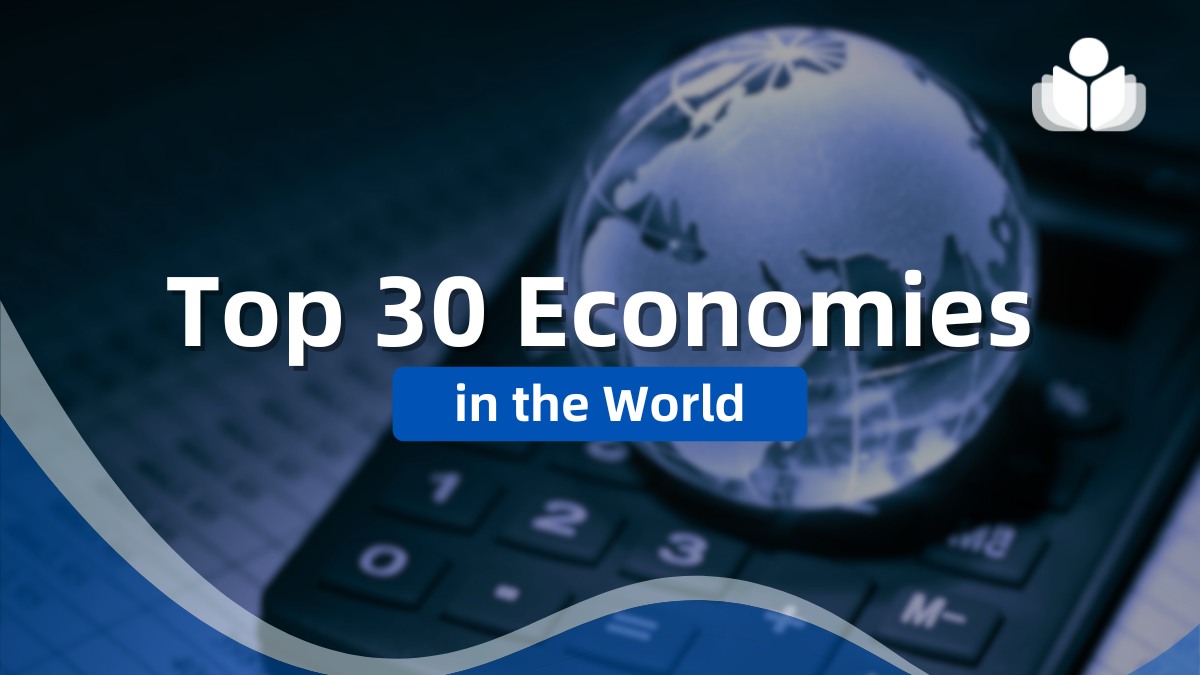In the dynamic world of global economics, ranking the world’s largest economies provides insight into which countries are the leading players on the international stage. Gross Domestic Product (GDP) is a crucial metric used to measure countries’ economic performance. It represents the total market value of all finished goods and services produced within a country in a given period.
This article delves into the top 30 economies in the world in 2024, highlighting their key sectors, strengths, and unique contributions to the global economy.
1. United States
GDP: $28.8 trillion
Region: North America
Key Sectors: Services, manufacturing, finance, technology
The United States continues to be the world’s largest economy. Known for its diverse and technologically advanced economic structure, the U.S. economy benefits from a robust consumer market, a highly developed financial sector, and industrial solid output.
Key growth sectors include information technology, healthcare, finance, and manufacturing. The country’s ability to innovate and adapt to new economic challenges has been pivotal in maintaining its leading status.
2. China
GDP: $18.5 trillion
Region: East Asia
Key Sectors: Manufacturing, exports, investment
China has seen rapid economic growth over the past few decades, largely driven by its manufacturing and export capabilities. The country has a significant labor force and substantial government support for infrastructure and industrial projects. China’s expanding consumer market and its role as a global manufacturing hub have cemented its position as the second-largest economy in the world.
3. Japan
GDP: $4.4 trillion
Region: East Asia
Key Sectors: Technology, automotive, electronics
Japan’s economy is characterized by its technological innovation and high-quality manufacturing sectors. Major industries include automotive, electronics, and machinery. Japan’s commitment to research and development and its skilled workforce contribute significantly to its economic strength.
4. Germany
GDP: $4.3 trillion
Region: Europe
Key Sectors: Engineering, automotive, chemicals
Germany is Europe’s largest economy, known for its engineering prowess and strong industrial base. Key sectors include automotive, machinery, chemicals, and pharmaceuticals. Germany’s export-oriented economy benefits from its reputation for high-quality and precision-engineered products.
5. India
GDP: $3.9 trillion
Region: South Asia
Key Sectors: IT, services, agriculture
India’s economy is diverse and rapidly growing, with significant contributions from the information technology sector, services, and agriculture. The country has a large and young workforce, and its expanding middle class continues to drive domestic consumption. India’s economic reforms and focus on digital transformation are crucial for its growth trajectory.
6. United Kingdom
GDP: $3.5 trillion
Region: Western Europe
Key Sectors: Services, finance, manufacturing
The UK’s economy is heavily service-oriented, with London being a major global financial center. Other important sectors include manufacturing, creative industries, and education. The UK’s economy benefits from its openness to trade and investment, as well as its strong legal and business infrastructure.
7. France
GDP: $3.1 trillion
Region: Western Europe
Key Sectors: Aerospace, tourism, luxury goods
France has a well-diversified economy with strengths in aerospace, luxury goods, agriculture, and tourism. The country’s strong social welfare system and significant public sector involvement in the economy contribute to its stability and growth. France is also a leader in innovation and research, particularly in sectors like pharmaceuticals and technology.
8. Brazil
GDP: $2.3 trillion
Region: South America
Key Sectors: Agriculture, mining, manufacturing
Brazil’s economy is the largest in South America, with major contributions from agriculture, mining, and manufacturing. The country is a leading global exporter of commodities like soybeans, coffee, and iron ore. Brazil’s economic growth is influenced by commodity prices and domestic consumption.
9. Italy
GDP: $2.3 trillion
Region: Europe
Key Sectors: Manufacturing, agriculture, luxury goods
Italy’s economy is known for its manufacturing sector, particularly in high-quality consumer goods and luxury products. Key industries include fashion, automotive, and machinery. Italy’s agricultural sector also plays a significant role in producing wine and olive oil.
10. Canada
GDP: $2.2 trillion
Region: North America
Key Sectors: Natural resources, services, manufacturing
Canada’s economy relies heavily on its vast natural resources, including oil, gas, minerals, and timber. The country also has a strong services sector and a well-developed manufacturing industry. Canada’s commitment to innovation and technology to support its economic growth.
11. Russia
GDP: $2.1 trillion
Region: Europe/Asia
Key Sectors: Energy, mining, manufacturing
Russia’s economy is largely driven by its energy sector, with significant oil and natural gas reserves. Other important industries include mining and manufacturing. Russia’s economic performance is closely linked to global energy prices and its geopolitical relationships.
12. Mexico
GDP: $2.0 trillion
Region: North America
Key Sectors: Manufacturing, oil, services
Mexico has a diverse economy with strong manufacturing and oil sectors. The country benefits from its strategic location and trade agreements with the United States and other countries. Mexico’s services sector, including tourism, also plays a vital role in its economy.
13. Australia
GDP: $1.8 trillion
Region: Oceania
Key Sectors: Mining, services, agriculture
Australia’s economy is rich in natural resources, particularly minerals and energy. The country also has a robust services sector, including education and tourism. Australia’s economic stability is supported by its strong regulatory framework and open trade policies.
14. South Korea
GDP: $1.8 trillion
Region: East Asia
Key Sectors: Electronics, automotive, shipbuilding
South Korea’s economy is known for its advanced technology and manufacturing sectors. Key industries include electronics, automotive, and shipbuilding. South Korea’s focus on innovation and education has propelled its economic growth and global competitiveness.
15. Spain
GDP: $1.7 trillion
Region: Europe
Key Sectors: Tourism, manufacturing, agriculture
Spain’s economy is diverse, with significant contributions from tourism, manufacturing, and agriculture. The country is a popular tourist destination and a major producer of agricultural products like olives and wine. Spain’s manufacturing sector is also strong, particularly in the automotive and textile sectors.
16. Indonesia
GDP: $1.5 trillion
Region: Southeast Asia
Key Sectors: Agriculture, manufacturing, services
Indonesia’s economy is the largest in Southeast Asia, driven by its agriculture, manufacturing, and services sectors. The country has a large domestic market and significant natural resources. Indonesia’s strategic location and growing middle class support its economic growth.
17. Netherlands
GDP: $1.1 trillion
Region: Europe
Key Sectors: Trade, services, manufacturing
The Netherlands has a highly developed economy known for its trade and logistics sectors. Key industries include services, manufacturing, and agriculture. The country’s strategic location in Europe makes it a critical hub for trade and transportation.
18. Turkey
GDP: $1.1 trillion
Region: Asia/Europe
Key Sectors: Manufacturing, agriculture, services
Turkey’s economy is diverse, with strong manufacturing and agricultural sectors. The country is a major producer of textiles, electronics, and automotive parts. Turkey’s strategic location and growing domestic market contribute to its economic significance.
19. Saudi Arabia
GDP: $1.1 trillion
Region: Middle East
Key Sectors: Oil, petrochemicals, services
Saudi Arabia’s economy is heavily reliant on its vast oil reserves. The country is the largest exporter of oil in the world. Saudi Arabia is investing in diversifying its economy through initiatives like Vision 2030, which aims to reduce its dependence on oil and develop other sectors such as tourism and entertainment.
20. Switzerland
GDP: $938 billion
Region: Europe
Key Sectors: Finance, pharmaceuticals, machinery
Switzerland’s economy is known for its stability, strong financial sector, and high-quality manufacturing. Key industries include banking, pharmaceuticals, and precision machinery. Switzerland’s robust legal framework and business-friendly environment attract significant foreign investment.
21. Taiwan
GDP: $803 billion
Region: East Asia
Key Sectors: Electronics, manufacturing, services
Taiwan’s economy is heavily driven by its electronics and semiconductor industries, making it a critical player in the global supply chain for technology products. The country’s focus on high-tech manufacturing and strong service sectors have fueled its economic growth. Taiwan’s strategic investments in research and development continue to enhance its competitiveness on the world stage.
22. Poland
GDP: $845 billion
Region: Europe
Key Sectors: Manufacturing, agriculture, services
Poland has experienced steady economic growth, bolstered by its robust manufacturing sector, agricultural output, and expanding services industry. The country’s strategic location in Europe makes it a vital hub for trade and logistics. Investments in infrastructure and technological advancements are further driving its economic development.
23. Sweden
GDP: $625 billion
Region: Europe
Key Sectors: Manufacturing, services, technology
Sweden’s economy is characterized by a high standard of living, advanced technology, and a strong industrial base. Key sectors include manufacturing, particularly in automotive and machinery, as well as information technology and telecommunications. Sweden’s commitment to sustainability and innovation continues to underpin its economic resilience and growth.
24. Belgium
GDP: $600 billion
Region: Europe
Key Sectors: Trade, services, manufacturing
Belgium’s strategic location in Europe and its well-developed logistics infrastructure make it a critical center for trade and commerce. The country’s economy is diversified, with strong sectors in services, manufacturing, and agriculture. Belgium is also known for its robust pharmaceutical and chemical industries.
25. Argentina
GDP: $655 billion
Region: South America
Key Sectors: Agriculture, manufacturing, services
Argentina’s economy is one of the largest in South America, with significant contributions from agriculture, manufacturing, and services. The country is a leading exporter of agricultural products, including soybeans and beef. Argentina’s industrial sector, particularly in automotive and food processing, is vital in its economic landscape.
26. Ireland
GDP: $546 billion
Region: Europe
Key Sectors: Pharmaceuticals, technology, services
Ireland’s economy is highly advanced, with significant contributions from the pharmaceutical, technology, and services sectors. The country has attracted substantial foreign direct investment, particularly from multinational corporations in the tech and pharmaceutical industries. Ireland’s favorable business environment and skilled workforce support its economic growth and innovation.
27. Austria
GDP: $520 billion
Region: Europe
Key Sectors: Manufacturing, tourism, services
Austria’s economy is characterized by a strong industrial base, a thriving tourism sector, and a well-developed services industry. Key industries include machinery, vehicles, and chemicals. Austria’s strategic location in central Europe makes it an important hub for trade and logistics, supporting its economic stability and growth.
28. Thailand
GDP: $515 billion
Region: Southeast Asia
Key Sectors: Tourism, agriculture, manufacturing
Thailand’s economy benefits from a diverse range of sectors, including tourism, agriculture, and manufacturing. The country is a popular tourist destination, contributing significantly to its GDP. Thailand’s agricultural sector, particularly rice production, and its growing manufacturing industry, especially in electronics and automobiles, are key economic drivers.
29. Israel
GDP: $509 billion
Region: Middle East
Key Sectors: Technology, manufacturing, services
Israel’s economy is driven by its high-tech sector, which is a global leader in innovation and startup activity. The country also has strong manufacturing and services industries. Israel’s emphasis on research and development, particularly in technology and defense, underpins its economic strength and global competitiveness.
30. United Arab Emirates
GDP: $504 billion
Region: Middle East
Key Sectors: Oil, trade, tourism
The UAE’s economy is heavily reliant on its oil and gas sector, which remains a significant source of revenue. However, the country has substantially diversified its economy, investing in trade, tourism, and financial services. The UAE’s strategic location as a global trading hub and its ambitious development projects, such as the Expo 2020 in Dubai, contribute to its economic growth.
Conclusion
The top 30 economies in the world for 2024 showcase diverse strengths and industries. From the technological advancements in the United States and China to the manufacturing prowess of Germany and Japan, these economies leverage their unique assets to drive growth and innovation.
Emerging economies like India and Brazil continue to expand their influence, while smaller but highly developed nations like Switzerland and Sweden maintain robust economic health through strategic investments and innovation.
Understanding these economies provides valuable insights into global economic trends and the factors that contribute to economic success on the world stage.
 Sections of this topic
Sections of this topic
















